Not every aquarium enthusiast has encountered the bichir, but those who have are unlikely to forget this fascinating and unique fish, often referred to as the “dragon bichir” due to its striking appearance. In this article, you’ll learn about the essential aspects of bichir care, including feeding, tank mates, and overall maintenance.
While it’s challenging to cover every genus of bichir in detail, most species share similar care requirements. One crucial consideration is the size of the bichir, as some species grow quite large and may not be suitable for home aquariums due to their size. Understanding these needs and the implications of size will help you provide the best environment for your bichir, ensuring a healthy and thriving addition to your tank.
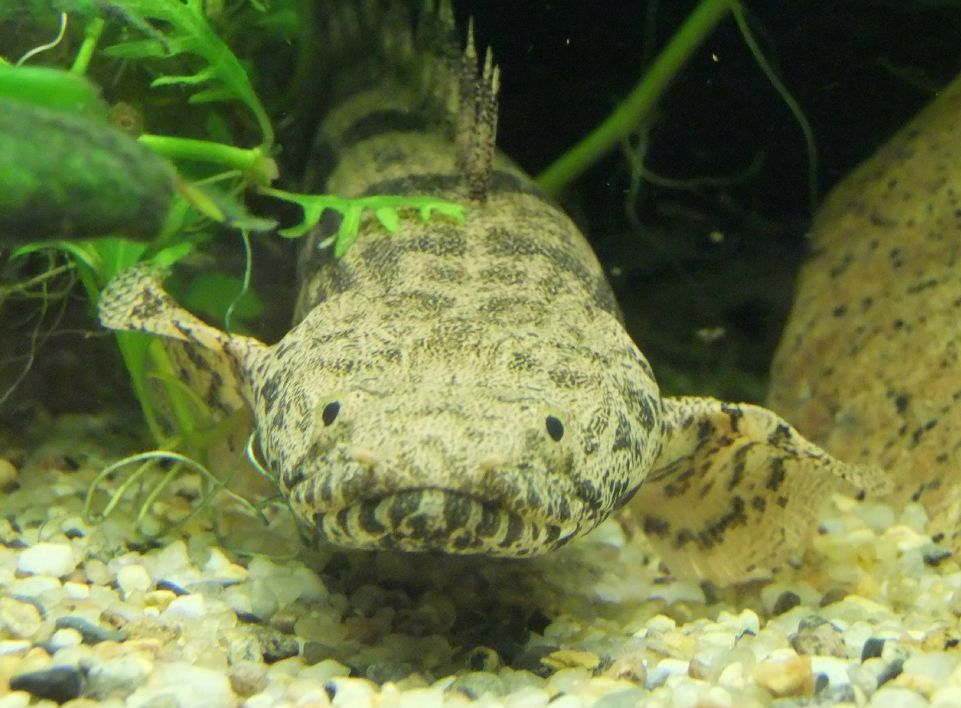
Contents
Habitat in the wild
Bichirs, also known as dinosaur bichirs (family Polypteridae), are a unique group of freshwater ray-finned fishes. They are the sole members of the order Polypteriformes and the subclass Cladistia, comprising two genera: Polypterus and Erpetoichthys.
There are currently 14 recognized species of bichirs, with their natural habitats spread across tropical Africa. Among these, the Erpetoichthys calabaricus, commonly known as the reedfish or ropefish, is particularly notable.
This ancient lineage of fish shares similarities with lobe-finned fishes and lungfishes, having evolved independently. Fossil evidence shows that bichirs have existed for around 60 million years, dating back to the Mesozoic era.
Modern bichirs are found in various freshwater basins in Africa, including the Nile, Congo, and Niger river systems. They inhabit swamps, rivers, and lakes with slow-moving or stagnant water, often preferring muddy environments and silted bottoms. Bichirs navigate these murky waters primarily using their keen sense of smell, as their vision is relatively poor.
Adapted to low-oxygen environments, bichirs possess both gills and a specialized swim bladder, known as a lung, which allows them to breathe air. This adaptation is crucial for surviving in oxygen-poor conditions.
In terms of water parameters, bichirs can tolerate a range of conditions. They thrive in slightly acidic to slightly alkaline water with temperatures between 75 to 82 degrees Fahrenheit (24 to 28 degrees Celsius).
Bichirs are nocturnal and exhibit a secretive, solitary nature. They are often found hiding among vegetation or in crevices during the day. As carnivores, they primarily feed on small fish, invertebrates, and occasionally amphibians. In captivity, bichirs can be trained to accept various prepared foods.
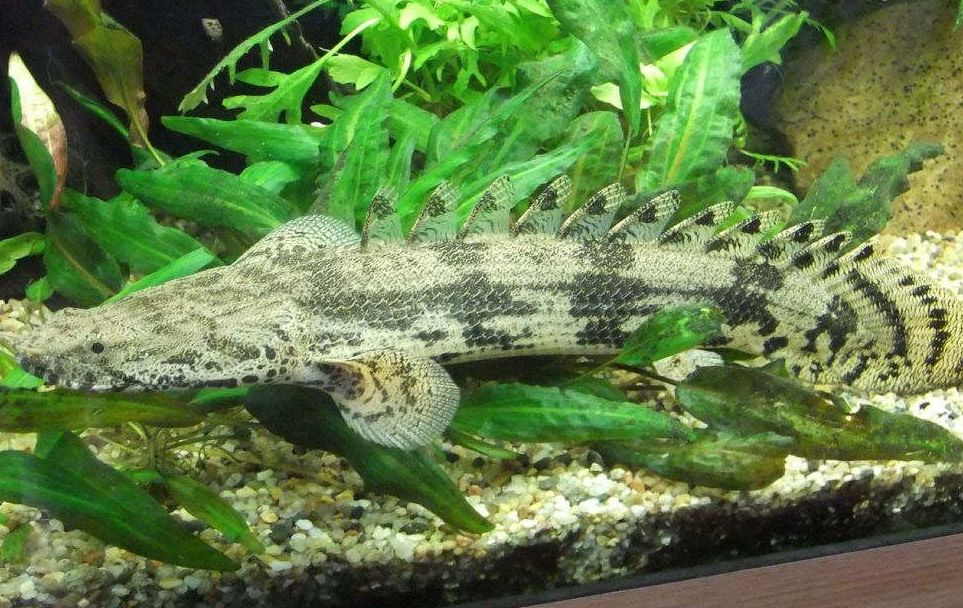
Description
Bichirs, known for their ancient and primitive appearance, have bodies that evoke the look of prehistoric fish. Their skeletons resemble those of sharks but are made of cartilage rather than bone, giving them an archaic look.
Bichirs (family Polypteridae) vary in size depending on the species. While some species can exceed 100 cm (39 inches) in length, most bichirs are smaller, typically reaching lengths of up to 25 cm (9.8 inches). Here’s a general overview of the size range for different species:
- Senegal Bichir (Polypterus senegalus): This commonly available species can grow to about 12 to 20 inches (30 to 50 centimeters) in length.
- West African Bichir or Retropinnis Bichir (Polypterus retropinnis): Typically reaches about 10 to 14 inches (25 to 35 centimeters) in length.
- Ornate Bichir (Polypterus ornatipinnis): Larger in size, adults can reach 18 to 24 inches (45 to 60 centimeters).
- Delhezi Bichir (Polypterus delhezi): Grows to about 16 to 20 inches (40 to 50 centimeters).
- Lapradei Bichir (Polypterus lapradei): One of the larger species, it can grow to lengths of 20 to 30 inches (50 to 75 centimeters) or more.
Bichirs are known for their longevity, with some individuals living 15 to 20 years or more in captivity, provided they receive proper care.
Physically, bichirs have elongated bodies covered in diamond-shaped, flexible scales that act as armor against predators. They possess several pairs of lobed fins that resemble limbs, and their dorsal fin consists of 5 to 18 small, distinct fins, contributing to their name.
Their pectoral fins have evolved from a fleshy blade, giving them a lobe-finned fish-like appearance, although their internal skeleton is quite different. Bichirs are also equipped with a specialized air-bladder consisting of two sections: a larger right section and a smaller left section. These sections are connected to the intestinal tract by a common channel, functioning as an additional respiratory organ alongside their gills. This adaptation allows bichirs to breathe air from the surface, which is especially useful in oxygen-poor environments. Unlike lungfishes, bichirs do not have choanas.
Difficulties in keeping
Bichirs have been kept in home aquariums since the early 20th century. These ancient fish are generally easy to care for, as they are hardy and can tolerate less-than-ideal water conditions. Their adaptability makes them a relatively low-maintenance option for aquarists.
However, it’s important to note that bichirs are predators. Therefore, they should be housed with only large fish that can withstand their predatory nature. Additionally, bichirs are slow foragers and may struggle to compete for food with faster-moving tank mates, which can lead to starvation if not properly managed.
For beginners interested in keeping bichirs, it is essential to provide suitable tank conditions. While bichirs are relatively easy to care for, their specific needs and unique behavior make them best suited for aquarists who can meet their requirements and offer a well-planned tank environment.
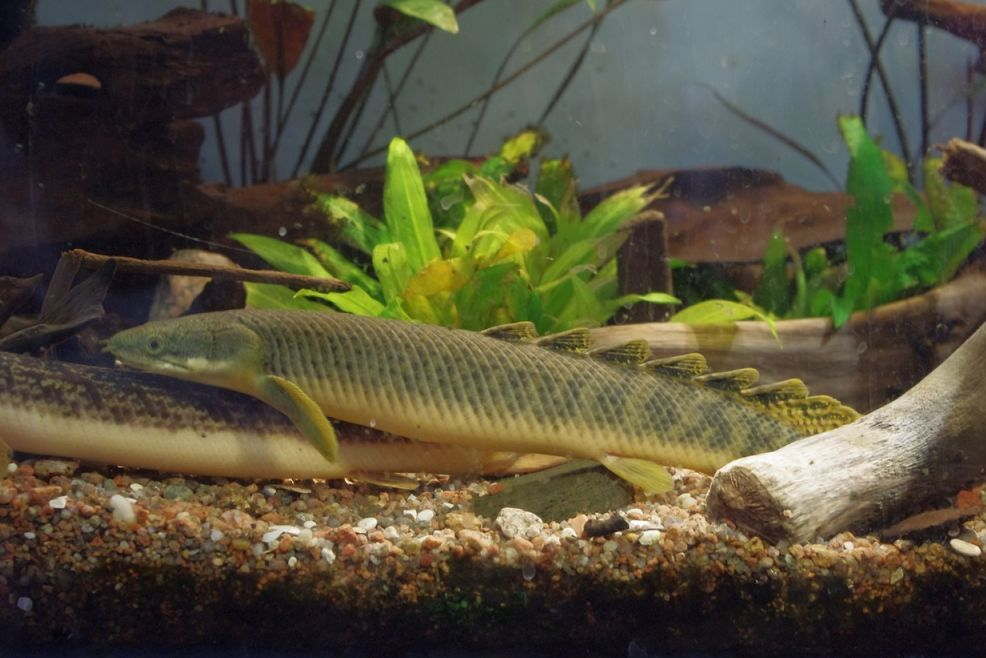
Keeping in a tank
Tank size
The appropriate tank size for bichirs varies depending on the species and its expected adult size. These fish can grow quite large, so it’s crucial to provide a spacious tank that accommodates their size and swimming needs. A tank with a minimum capacity of 44 gallons (200 liters) is recommended, though larger tanks are even better.
A secure cover is essential for any tank. Bichirs are known for their ability to both jump and crawl out of the tank, making a cover necessary to prevent escapes. Additionally, ensure there is sufficient air space between the tank cover and the water surface. This gap allows the bichir to breathe effectively, as they rely on atmospheric oxygen in addition to gill respiration.
Water parameters
Temperature: Bichirs are tropical fish and thrive in water temperatures ranging from 75 to 82 degrees Fahrenheit (24 to 28 degrees Celsius). Maintaining a stable temperature is crucial, as sudden fluctuations can stress the fish and impact their health.
pH Level: Bichirs are quite adaptable to varying pH levels, with an ideal range typically between 6.5 and 8.0. However, some species may have specific pH requirements, so it is important to research the needs of the particular species you are keeping.
Hardness: Bichirs can tolerate both soft and hard water, but it is advisable to avoid extremely hard water (above 20 dGH). A general hardness range of 5 to 20 dGH is suitable for most species.
Ammonia, Nitrite, and Nitrate: Bichirs are sensitive to ammonia and nitrite, which are toxic byproducts of fish waste and decaying matter. Regular monitoring is essential to keep ammonia and nitrite levels at zero, while nitrate levels should be kept below 20 parts per million (ppm). This helps prevent water quality issues that could harm the fish.
Filtration and Water Quality: Efficient filtration is crucial for maintaining good water quality. A well-sized and properly maintained filter will handle the waste produced by bichirs and help keep water parameters stable.
Water Changes: Regular partial water changes are necessary to manage water quality and dilute toxins or impurities. Aim for a 20% to 30% water change every 1 to 2 weeks, although the exact frequency and volume may vary based on the tank size and the specific needs of your fish.
Aeration: While bichirs themselves do not require additional aeration, having aeration in the tank benefits the overall ecosystem by promoting better oxygenation and water circulation.
Tank decor
Tank decorations may be of any kind you like. Stones, caves, castles will do. Live tank plants are desirable, but not necessary.
Since bichirs is mostly a bottom-feeder, the tank bottom substrate should be easy in care and cleaning. It’s better be a thin layer of sand, though small grained gravel will do as well. But the latter is less natural like for the fish and it will be more difficult for the fish to feed from it.
Some aquarists advise to keep bichirs in an empty tank, to decrease their territory dependence. But the view of the fish swimming in a tank without decorations or caves is a bit depressing. On the other hand, the fish looks more fascinating when it is slowly creeping up between tank plants or stones in a good decorated tank.
Smooth stones, snags, caves will perfectly do as tank decorations. You can also use ceramic and plastic tubes, but they look less natural.
Filtration in tank – it’d be excellent to have a powerful canister filter with ability to clean water using both mechanical and biological filtration. Though the bichir is not quite active and it doesn’t leave much litter if compared to other fishes, but protein food is a source of many small leftovers, that make tank water toxic very fast without proper filtration.
Substrate
Bichirs prefer a soft substrate that allows them to burrow and partially or completely bury themselves. Ideal substrates include sand, fine gravel, or a mix of sand and small, rounded pebbles. Avoid sharp or rough substrates, as they could injure the bichir’s delicate skin. To accommodate their natural digging behaviors and provide a comfortable resting place, ensure the substrate is at least 2 to 3 inches (5 to 8 centimeters) deep. This depth enables bichirs to engage in their instinctive behaviors and enhances their overall well-being.
Diet
Diet: In their natural habitat, bichirs consume small fish, invertebrates, and occasionally amphibians. To meet their dietary needs in an aquarium, it’s essential to offer a varied and nutritious diet.
Feeding: Bichirs are predatory fish and thrive on a diet rich in meaty foods. Their diet should primarily consist of live or frozen foods, including small fish (like guppies), bloodworms, blackworms, frozen shrimp, small fish pieces, ox heart, meat, and earthworms. Offering a variety of these meaty options ensures they receive balanced nutrition.
While bichirs can eat artificial foods, such as high-quality pellets or sinking carnivore-specific pellets, this is less natural for them. Choose pellets that sink quickly, as bichirs are primarily bottom-dwellers.
Feeding Behavior: Bichirs have a unique feeding behavior; they use their tube-like mouth to suck in prey. To encourage their natural hunting instincts, use feeding tongs or tweezers to present food in front of them. This method allows them to actively hunt and capture their prey. Ensure the food is appropriately sized for their mouth to prevent blockages or stress. Adjust the size of the food as the bichir grows.
Feeding Frequency: They are opportunistic feeders with varying feeding needs based on size and age. Juvenile may need daily feedings, while adults can be fed every other day or even every few days. Monitor their appetite and adjust the feeding schedule to avoid overfeeding.
tank mates
Any fish will do as bichir tank mate, the main thing is that it shoudln’t fit into its mouth. Bichirs have a tendency to eat smaller fish and invertebrates, so it’s crucial to choose tankmates that are compatible with their behavior and size. Bichir never attack large healthy fish without a reason. Sometimes they may even attack the fish of larger size, though usually this happens due to the bad eyesight.
Fishes of the same size as fish will do as its tank mates. These can be oscar, blood parrot, green terror and so on. I wouldn’t recommend to keep together with flowerhorn, since the latter may kill even such a protected fish.
Here’s a chart that provides some examples of potential tankmates for bichirs based on their size, temperament, and compatibility:
| Bichir Species | Tankmate Suggestions |
|---|---|
| Polypterus senegalus | Larger catfish species (e.g., Synodontis species), larger tetras (e.g., Buenos Aires tetra), larger barbs (e.g., Tiger barb), larger gouramis (e.g., Pearl gourami) |
| Polypterus retropinnis | Larger catfish species, larger tetras, larger barbs, larger gouramis, larger loaches (e.g., Clown loach), larger danios (e.g., Giant danio) |
| Polypterus ornatipinnis | Larger catfish species, larger tetras, larger barbs, larger gouramis, larger loaches, larger danios, larger cichlids (e.g., Angelfish) |
| Polypterus delhezi | Larger catfish species, larger tetras, larger barbs, larger gouramis, larger loaches, larger danios, larger cichlids, larger characins (e.g., Silver dollar fish) |
| Polypterus lapradei | Larger catfish species, larger tetras, larger barbs, larger gouramis, larger loaches, larger danios, larger cichlids, larger characins |
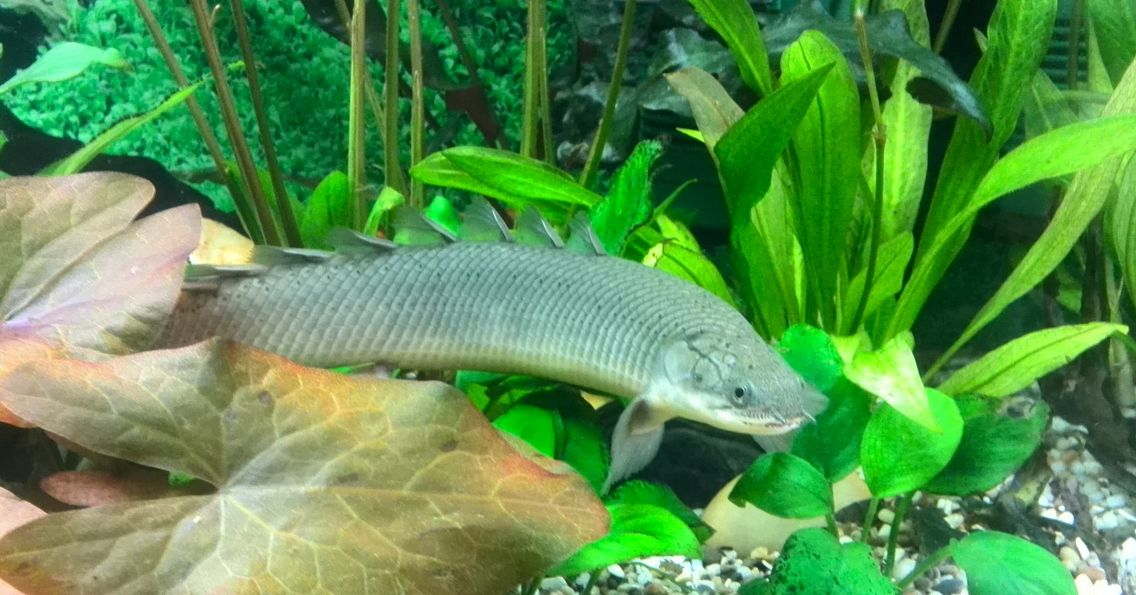
Gender differences: male vs female
Distinguishing between male and female bichirs can be challenging, but there are some indirect features that can help:
- Fin Structure: Males typically have wider and thicker anal and dorsal fins compared to females.
- Body Size: Females are generally larger in size and may have a rounder and fuller body shape, especially during the breeding season when they are carrying eggs.
- Genital Papilla: In mature females, a small genital papilla or breeding tube may be visible near the vent area. However, this characteristic may not be apparent until the fish is ready to reproduce.
Juveniles: For young bichirs, it is nearly impossible to distinguish males from females as they have not yet developed the distinct physical characteristics of adults.
Breeding
In a home aquarium bichirs breed quite seldom. Breeding in an aquarium setting can be a complex process, as it requires providing the right conditions and stimulating natural behaviors.
Types of bichirs
Senegal bichir (Polypterus senegallus)
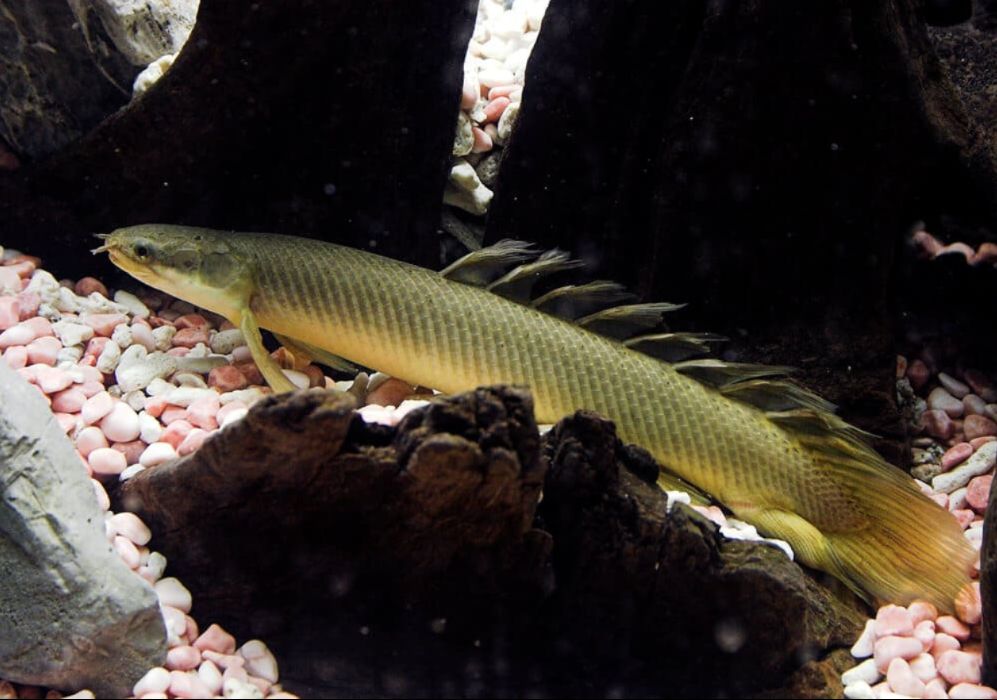
This is one of the most active and less timid Polypterids species. It is native to freshwater habitats in West Africa, specifically the Senegal and Gambia River basins. It actively swims almost all the time, it is curious and persistent. The fish doesn’t show aggression towards its kind and other tank dwellers if the latter are large enough.
They prefer a tank with a minimum capacity of 50 gallons (190 liters) or larger, with a sandy substrate and plenty of vegetation and driftwood. They are generally peaceful towards other tank mates, but caution should be exercised with smaller fish that can fit into their mouth.
The fish is reasonably large – adult senegal bichirs can grow up to 14-20 inches (35-50 cm) in length in captivity, depending on their environment and diet. Males tend to be slightly larger than females. I must say, that this is the fish you should get when you start getting to know Polypterids species.
| Characteristic | Description |
|---|---|
| Common Name | Senegal bichir, gray bichir, Cuvier’s bichir |
| Scientific Name | Polypterus senegalus |
| Family | Polypteridae |
| Native Region | West Africa (Senegal and Gambia River basins) |
| Appearance | Long and slender body with ganoid scales |
| Coloration | Light gray to dark brown with a mottled pattern |
| Maximum Size | 14-20 inches (35-50 cm) in length |
| Fin Structure | Elongated dorsal fin along most of the body |
| Respiratory Adaptation | Possess lungs in addition to gills |
| Behavior | Nocturnal, solitary, and capable of breathing atmospheric air |
| Diet | Piscivorous (fish), crustaceans, and insects |
| Aquarium Care | Minimum tank size of 50 gallons, ample hiding spots |
| Compatibility | Generally peaceful, but caution with smaller tank mates |
| Lifespan | 10-15 years or more in captivity |
| Water Parameters | – Temperature: 75-82°F (24-28°C) |
| – pH: 6.0-7.5 | |
| – Hardness: Soft to moderately hard |
Ornate bichir (Polypterus ornatipinnis)
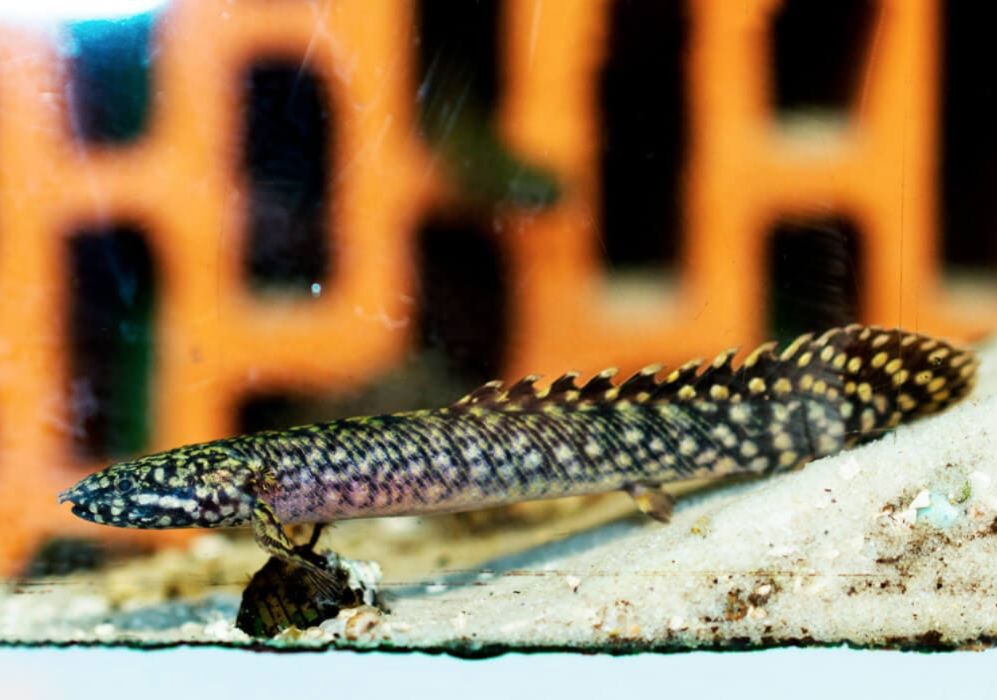
This is one of the most appealing Polypterids fishes. But unfortunately, it is very timid and you will seldom see it during a day, except when it comes out for food.
Besides the fish is more aggressive towards its kind and may take food from other fishes. It grows to become larger than the previous fish – 60 cm (24 in) in length and therefore it requires more roomy tank. This is a very strong predator fish capable of catching even a fast fish.
| Characteristic | Description |
|---|---|
| Common Name | Ornate bichir |
| Scientific Name | Polypterus ornatipinnis |
| Family | Polypteridae |
| Native Region | Central Africa (Congo River basin) |
| Appearance | Elongated body with bony plates (ganoid scales) |
| Coloration | Dark brown to black with white or yellow spots and markings |
| Maximum Size | Up to 24 inches (60 cm) in length |
| Fin Structure | Elongated dorsal fin running along the back |
| Respiratory Adaptation | Possess lungs in addition to gills |
| Behavior | Nocturnal and primarily solitary |
| Diet | Carnivorous, feeding on fish, crustaceans, and insects |
| Aquarium Care | Minimum tank size of 75 gallons or larger, ample hiding spots |
| Compatibility | Generally peaceful, but may prey on smaller tank mates |
| Lifespan | 10-15 years or more in captivity |
| Water Parameters | – Temperature: 75-82°F (24-28°C) |
| – pH: 6.0-7.5 | |
| – Hardness: Soft to moderately hard |
Saddled bichir (Polypterus endlicheri)
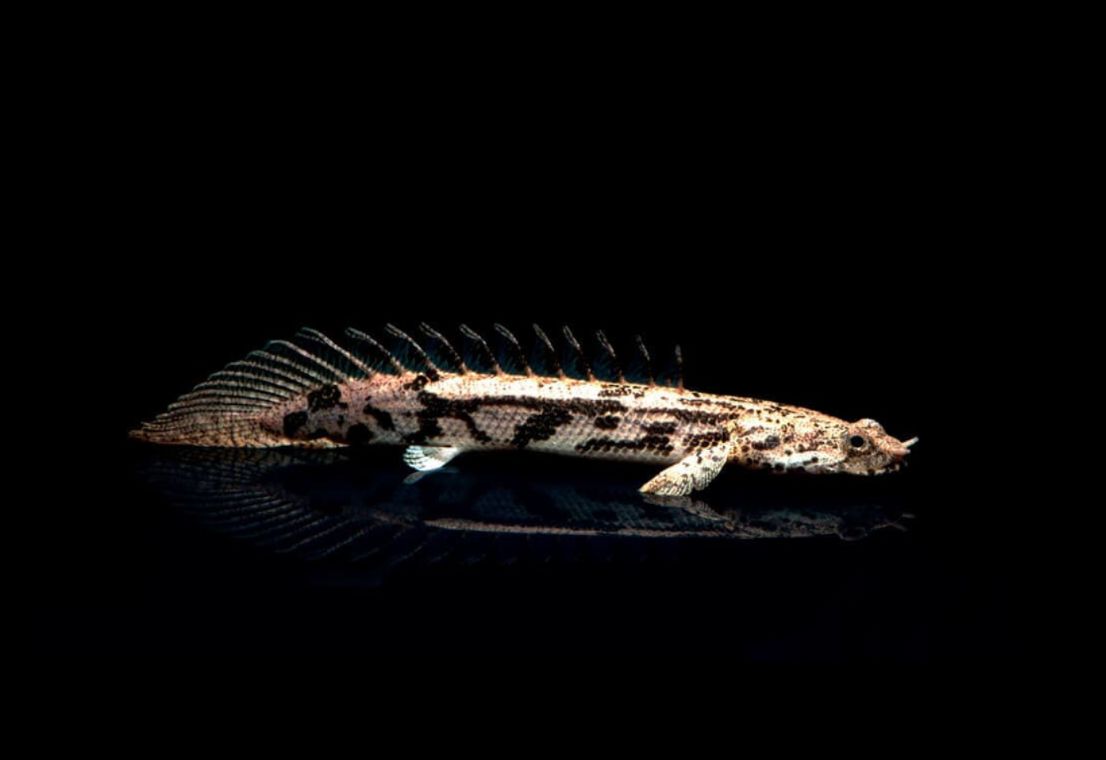
Polypterus endlicheri is a large and strong species, that grows to become up to 75 cm in the wild. It is not very active during a day, it mainly slowly swims looking for food. Considering the size, it’s better to keep it in a separate tank and feed with live food (once or twice a week).
| Characteristic | Description |
|---|---|
| Common Name | Saddled bichir or Endlicheri bichir |
| Scientific Name | Polypterus endlicheri |
| Family | Polypteridae |
| Native Region | Central and West Africa, including the Congo River basin |
| Appearance | Elongated body with ganoid scales |
| Coloration | Variable, ranging from olive to dark brown with saddled markings |
| Maximum Size | Up to 30 inches (75 cm) in length |
| Fin Structure | Elongated dorsal fin and paired pectoral and pelvic fins |
| Respiratory Adaptation | Possess lungs in addition to gills |
| Behavior | Nocturnal, primarily solitary and territorial |
| Diet | Piscivorous (fish), crustaceans, and insects |
| Aquarium Care | Large tank with a minimum capacity of 100 gallons (380 liters) |
| Compatibility | May be aggressive towards smaller tank mates |
| Lifespan | 15-20 years or more in captivity |
| Water Parameters | – Temperature: 75-82°F (24-28°C) |
| – pH: 6.5-7.5 | |
| – Hardness: Soft to moderately hard |
Barred bichir (Polypterus delhezi)
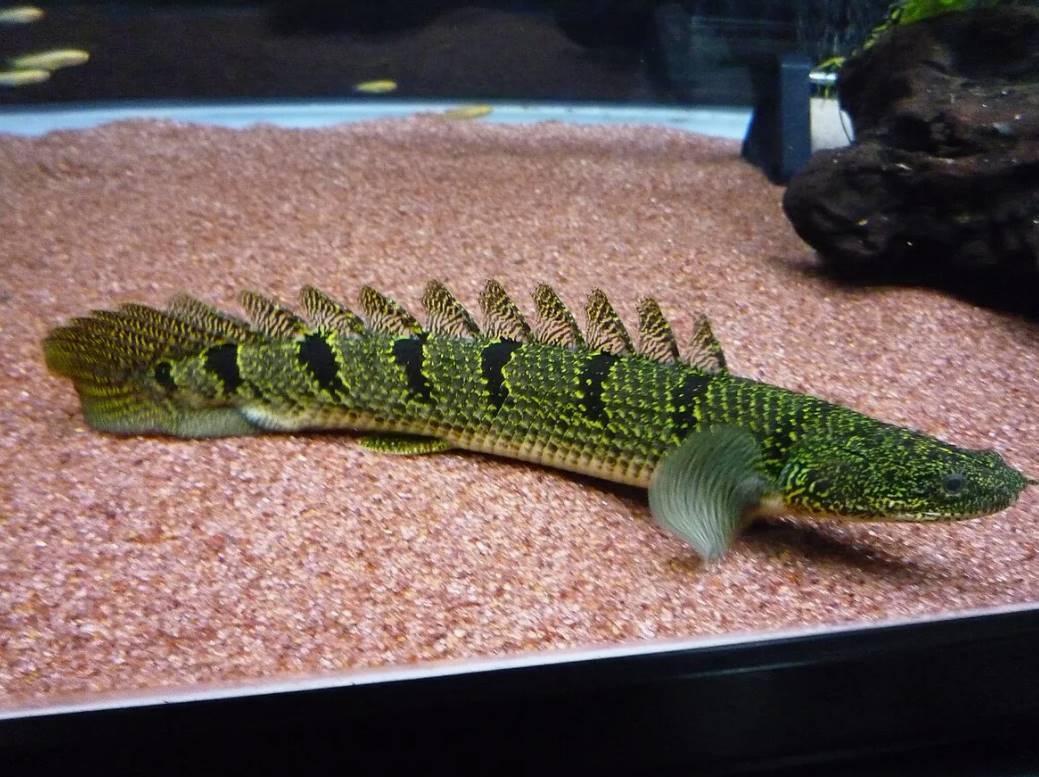
Polypterus delhezi, commonly known as the armored bichir or delhezi bichir, is a species of fish belonging to the family Polypteridae. Polypterus delhezi inhabits in Kongo river. It is not very active during a day and it spends its time in shelters. They are ambush predators, patiently waiting for their prey to come within striking distance. They are carnivorous and feed on a variety of prey, including small fish, crustaceans, insects, and other invertebrates. In captivity, they can be fed a diet of meaty foods such as fish fillets, shrimp, earthworms, and occasionally, feeder fish.
| Characteristic | Description |
|---|---|
| Common Name | Delhezi bichir |
| Scientific Name | Polypterus delhezi, barred bichir, armoured bichir |
| Family | Polypteridae |
| Native Region | Congo River basin in Central Africa |
| Appearance | Elongated body with bony plates (ganoid scales) |
| Coloration | Dark brown or black with lighter mottling |
| Maximum Size | Up to 14-16 inches (35-40 cm) in length |
| Fin Structure | Elongated dorsal fin running along most of the body |
| Respiratory Adaptation | Possess lungs in addition to gills |
| Behavior | Nocturnal, solitary, and can breathe atmospheric air |
| Diet | Piscivorous (fish), crustaceans, and insects |
| Aquarium Care | Minimum tank size of 50 gallons, plenty of hiding spots |
| Compatibility | Generally peaceful, but caution with smaller tank mates |
| Lifespan | 10-15 years or more in captivity |
| Water Parameters | – Temperature: 75-82°F (24-28°C) |
| – pH: 6.0-7.5 | |
| – Hardness: Soft to moderately hard |
Rope fish (Erpetoichthys calabaricus)
Erpetoichthys calabaricus is a fish species belonging to the family Polypteridae. Rope fish have a unique and elongated body, resembling a snake. They have a scaleless, cylindrical shape and typically grow to a length of about 12-20 inches (30-50 cm). When keeping fish in an aquarium, it is essential to provide them with a spacious tank. A minimum tank size of 50 gallons or more is recommended to accommodate their size and swimming needs. Ensure that the aquarium has a tight-fitting lid or cover as fish are known to be skilled escape artists.

| Characteristic | Description |
|---|---|
| Common Name | Reedfish or Ropefish |
| Scientific Name | Erpetoichthys calabaricus |
| Family | Polypteridae |
| Native Region | West and Central Africa, including Nigeria and Cameroon |
| Appearance | Elongated body with a snake-like appearance |
| Coloration | Light brown to dark gray with dark vertical bands |
| Maximum Size | Can reach up to 20-30 inches (50-75 cm) in length |
| Fin Structure | Long dorsal fin extending along most of the body |
| Respiratory Adaptation | Possess both gills and a modified swim bladder for breathing |
| Behavior | Nocturnal, peaceful, and curious |
| Diet | Carnivorous, feeding on small fish, insects, and worms |
| Aquarium Care | Minimum tank size of 50 gallons, tight-fitting lid |
| Compatibility | Generally peaceful, but may eat small tankmates |
| Lifespan | 8-15 years or more in captivity |
| Water Parameters | – Temperature: 72-82°F (22-28°C) |
| – pH: 6.0-7.5 | |
| – Hardness: Soft to moderately hard |